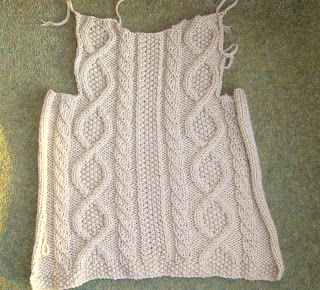This is the little Trellis cardigan in Jeanie by Peter Pan ( pattern from Knitty) This is a lofty cotton yarn of a chain construction, and it gives very crisp stitch definition, and a warm handle. However, cotton does not stitch up easily, which may be why the pattern designer suggested grafting the shoulders. The collar certainly sits very tidily. I bought the spotted buttons at a boot fair at 60p for the card - they seemed appropriate for the toddler who will be wearing this.
Lynne commented on my tableware post. One of my colleagues had a daughter who studied design. For her dissertation she looked at trends indicated by wedding lists. At first glance this seems rather trivial, but over time these lists must be revealing. Do people have dinner services or casserole dishes nowadays?
In the early 70's I began to collect the Denby pattern, Romany. This was because it was offered as breakfast sets on the pack of Alpen muesli. Muesli and this design have a lot in common. I have added pieces over the years and almost all of them are different, which I like but don't really understand, given that it is mass-produced. I really like the rounded shapes, although it is very much of its time.
In the 80's my husband, a bachelor, was being gifted these very splendid table-mats by his aunt, one per birthday. These built into a grand set - they show prints of London scenes.
While browsing around a china shop, one of my oldest friends pointed out a set called Holyrood - even the name does it for me. It was the exact complement to my husband's mats, so I began to collect it. He often remarks on how lucky it is that my china just happened to match the mats.
Recently, we have felt the need for something less formal, lighter in style. Doubtless, this follows a trend in the design world. This is Azure, purportedly by Royal Worcester.
I have not succumbed to square plates or slate mats, but I think you could map some interesting social changes from these three sets.
Knitting: I have finally sent off the collection of cowls. The first two were knitted on a long circular needle, while the third was knitted as a scarf and then seamed, as the yarn was pooling over longer stretches. Then there is a red scarf in an Aran yarn, and finally a neck warmer, knitted on a short circular, from Rowan Aran. I think that the red scarf is the most successful of the lot.




























































.JPG)